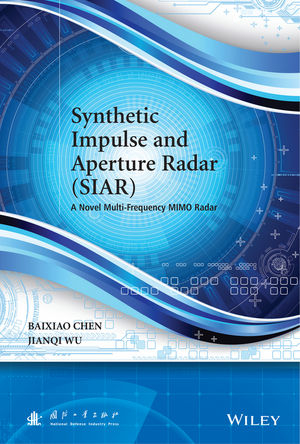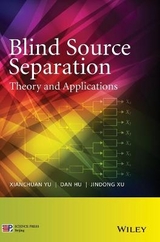
Synthetic Impulse and Aperture Radar (SIAR)
John Wiley & Sons Inc (Verlag)
978-1-118-60955-2 (ISBN)
Analyzes and discusses the operating principle, signal processing method, and experimental results of this advanced radar technology
This book systematically discusses the operating principle, signal processing method, target measurement technology, and experimental results of a new kind of radar called synthetic impulse and aperture radar (SIAR). The purpose is to help readers acquire an insight into the concept and principle of the SIAR, to know its operation mode, signal processing method, the difference between the traditional radar and itself, the designing ideals, and the developing method.
It includes 10 chapters. Chapter 1 gives an introduction to the basic principle of SIAR and its characteristic of four antis. Chapter 2 introduces the operating principles and system constitution of SIAR. Chapter 3 presents the main waveforms and the corresponding signal processing methods. Chapter 4 is about the long-time integration technique. Chapter 5 shows the high-accuracy measurement and tracking of 4D parameters of target in SIAR. The range-angle coupling and decoupling are introduced in Chapter 6, where a criteria for transmit frequency optimization of array elements is studied to overcome the coupling among range, azimuth and elevation. In Chapter 7, detection and tracking of targets in strong interference background is investigated. Chapter 8 analyzes quantitatively the influence of array error on the tracking accuracy of SIAR. Expansion of impulse and aperture synthesis to HF band and microwave band are introduced respectively in Chapter 9 and Chapter 10. The operating principle of the novel bi-static surface wave radar system, as well as the experimental system and the experimental results are included in Chapter 9.
Written by a highly experienced author with extensive knowledge of SIAR (Chen), the book can be used as a reference for engineering technical personnel and scientific research personnel working in the research of SIAR, MIMO radar, digital radar or other new type of radar. It can also be a reference for teachers and students in universities who engage in related professional work.
Details the operating principle, signal processing method, target measurement technology, and experimental results of synthetic impulse and aperture radar (SIAR)
Expands the technique of impulse and aperture synthesisfrom the VHF band to the HF band and the microwave band
Written by a leading author with many years’ research and practical experience in sparse array SIAR, a typical MIMO radar
Engineers, researchers and postgraduates working in radar engineering will find this an invaluable resource.
BAIXIAO CHEN, Xidian University, P. R. China JIANQI WU, Hefei Association for Science and Technology, P. R. China
About the Authors xiii
Preface xv
Acknowledgments xix
1 Introduction 1
1.1 Development of Modern Radar 1
1.2 Basic Features of SIAR 3
1.3 Four Anti Features of SIAR 4
1.4 Main Types of MIMO Radar 9
1.5 SIAR and MIMO Radar 11
1.6 Organization of This Book 12
References 15
2 Radar Common SignalWaveform and Pulse Compression 17
2.1 Mathematical Form and its Classification of Radar Signal 17
2.2 The Ambiguity Function and Radar Resolution 23
2.3 FM Pulse Signal and its Pulse Compression 38
2.4 Phase Coded Pulse Signal and its Processing 56
2.5 Stepped-Frequency Pulse Signal and its Processing 73
2.6 Orthogonal Waveform 84
2.7 MATLAB® Program List 95
References 102
3 System Design of SIAR 103
3.1 Introduction 103
3.2 Principles of SIAR 104
3.3 Synthesis of Transmit Pulse and Aperture 113
3.4 4D Ambiguity Function of SIAR 120
3.5 Radar Equation of SIAR and its Characteristics 126
3.6 Experimental System of SIAR 133
3.7 Gain and Phase Calibration of SIAR 137
3.8 Experimental Results of SIAR 142
3.9 SIAR with Large Random Sparse Array 145
3.10 Brief Summary 147
3.11 MATLAB® Program List 148
References 152
4 Waveform and Signal Processing of SIAR 155
4.1 Introduction 155
4.2 Waveform and Signal Processing Flow of SIAR 156
4.3 Application of LFM in SIAR 160
4.4 SIAR Performance Analysis of Pulse Compression based on Phased Codes 163
4.5 Pulse-to-Pulse Frequency Code Agility and its Signal Processing Flow 170
4.6 Group-to-Group Frequency Code Agility and its Signal Processing 179
4.7 Brief Summary 180
4.8 MATLAB® Program List 181
Appendix 4A Deductions of Some Equations in This Chapter 185
References 189
5 Long-Time Coherent Integration of SIAR 191
5.1 Introduction 191
5.2 Features and Faults of Long-Time Coherent Integration of SIAR 192
5.3 Long-Time Coherent Integration Based on Motion Compensation and Time-Frequency Analysis 197
5.4 Long-Time Coherent Integration Based on Pulse Synthesis of Stepped Frequency 203
5.5 Computer Simulation 210
5.6 Brief Summary 213
References 213
6 Digital Monopulse Tracking Technique of SIAR 215
6.1 Overview of the Monopulse Tracking Technique 215
6.2 Tracking Processing and Signal Model of SIAR 218
6.3 Precision Measurement of the Target Range 220
6.4 Measurements of the SIAR Target’s Direction 230
6.5 Measurement of Doppler Frequency 235
6.6 Brief Summary 238
References 239
7 Coupling and Decoupling between Range and Angle 241
7.1 Introduction 241
7.2 Coupling Influence of Angular Error on Range Measurement 242
7.3 Coupling Influence of Range Quantization Error on Angle Measurement 244
7.4 Range-Angle Coupling Analysis Based on the Fisher Information Matrix 247
7.5 Frequency Code Optimization and Three-Dimensional Decoupling Analysis 249
7.6 Computer Simulation 255
7.7 Brief Summary 256
References 257
8 Target Detection and Tracking in SIAR under Strong Jamming 259
8.1 Introduction 259
8.2 Anti-Jamming Measures of the SIAR System 260
8.3 Adaptive Nulling and Computer Simulation for the Phased Array Radar 261
8.4 Adaptive Nulling and Computer Simulation for SIAR 277
8.5 Target Range Measurement in SIAR Under Active Jamming 281
8.6 Target Direction Measurement in SIAR Under Active Jamming 283
8.7 Performance Analysis of Sidelobe Cancelation in SIAR 285
8.8 Summary 292
8.9 MATLAB® Program List 294
References 296
9 Effects of Array Error on SIAR Tracking Accuracy 297
9.1 Introduction 297
9.2 Effect of Amplitude and Phase of the Array Element on Tracking Accuracy 298
9.3 Influence of Channel Mismatch on Tracking Accuracy 303
9.4 Influence of Orthogonal Channel Imbalance on Tracking Accuracy 312
9.5 Summary 317
References 318
10 Bistatic Synthetic Impulse and Aperture GroundWave Radar Experimental System 319
10.1 Introduction 319
10.2 The Composition and Characteristics of the Test System 321
10.3 The Parameter Design of the Waveform of the Bistatic Synthetic Impulse and Aperture Ground Wave Radar 331
10.4 Working Principles of the Bistatic Synthetic Impulse and Aperture Ground Wave Radar 336
10.5 Sea Clutter Characteristic of the Bistatic HF Ground Wave Radar 347
10.6 Results of Real-Data Processing 359
10.7 Brief Summary 364
References 366
11 Microwave Sparse Array Synthetic Impulse and Aperture Radar 369
11.1 Introduction 369
11.2 Transmit Signal Waveform of MSA-SIAR 370
11.3 The Array and its Optimization of MSA-SIAR 372
11.4 The Signal Pre-processing Method Based on Digital Dechirp Processing 382
11.5 MSA-SIAR Based on IDFT Coherent Synthesis 387
11.6 Spatial Domain Synthetic Bandwidth Method of MSA-SIAR 392
11.7 Summary 400
References 401
Bibliography 405
Index 409
| Erscheint lt. Verlag | 4.4.2014 |
|---|---|
| Verlagsort | New York |
| Sprache | englisch |
| Maße | 173 x 246 mm |
| Gewicht | 816 g |
| Themenwelt | Technik ► Elektrotechnik / Energietechnik |
| Technik ► Nachrichtentechnik | |
| ISBN-10 | 1-118-60955-7 / 1118609557 |
| ISBN-13 | 978-1-118-60955-2 / 9781118609552 |
| Zustand | Neuware |
| Informationen gemäß Produktsicherheitsverordnung (GPSR) | |
| Haben Sie eine Frage zum Produkt? |
aus dem Bereich



